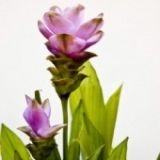PROFEED’s herbarium |
TURMERIC - Curcuma Longa - exotic, very beautiful and usefull plantreturnTurmeric grows wild in the forests of South and Southeast Asia. It has become the key ingredient for many Indian, Persian and Thai dishes such as in curry and many more. In Indonesia, the turmeric leaves are used for Minangese or Padangese curry base of Sumatra, such as rendang, sate padang and many other varieties. Although most usage of turmeric is in the form of root powder, in some regions (especially in Maharashtra), leaves of turmeric are used to wrap and cook food. This usually takes place in areas where turmeric is grown locally, since the leaves used are freshly picked. This imparts a distinct flavor. Turmeric is currently being investigated for possible benefits in Alzheimer's disease, cancer, arthritis, and other clinical disorders. As an example of preliminary laboratory research, turmeric ameliorated the severity of pancreatitis-associated lung injury in mice. In the latter half of the 20th century, curcumin was identified as responsible for most of the biological effects of turmeric. According to a 2005 article in the Wall Street Journal, research activity into curcumin and turmeric is increasing.The U.S. National Institutes of Health currently has registered 61 clinical trials completed or underway to study use of dietary curcumin for a variety of clinical disorders. source: http://en.wikipedia.org/wiki/Curcuma_longa |
